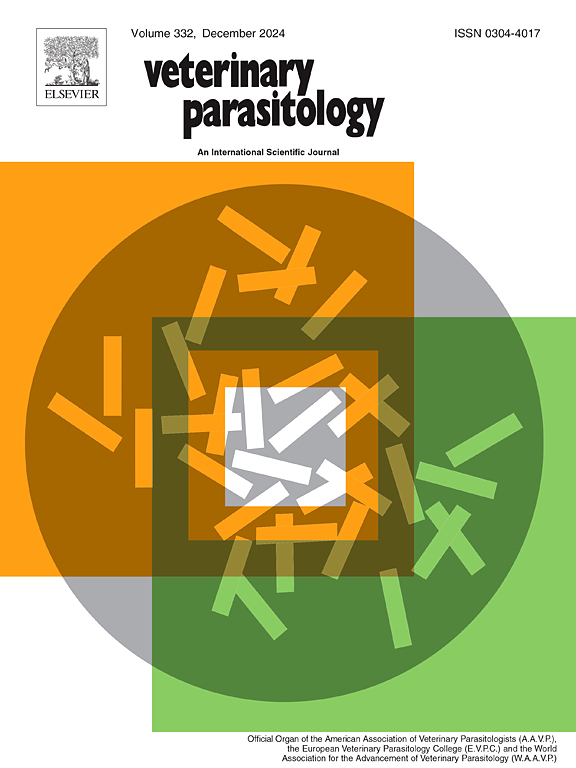黄粉虫甲虫(Tenebrio molitor)幼虫作为抗利什曼原虫药物评价的替代模型
IF 2
2区 农林科学
Q2 PARASITOLOGY
引用次数: 0
摘要
利什曼病是由利什曼属寄生虫引起的人畜共患疾病。可用的治疗方法有限,并伴有一系列不良反应。寻找潜在的新药包括体外和体内试验。啮齿动物主要被用作体内分析的实验模型。然而,这种做法引起了伦理问题,包括与环境影响和动物福利有关的问题。因此,出现了各种替代方法来避免或减少在实验室中使用哺乳动物进行临床前试验。本研究旨在评价黄粉虫幼虫对亚马逊利什曼原虫的感染情况。T. molitor幼虫感染promastigotes(1 ×10; 1×10⁶;和1 ×10⁷),并通过生存曲线、黑化程度、寄生负荷、细胞增殖和氧化应激水平(通过还原性谷胱甘肽(GSH)和亚硝酸盐水平测量)进行评估。利什曼原虫侵袭T.运动浆细胞后转化为胞内无尾鞭毛体。接种1个 × 105和1个 × 106的原毛体幼虫在24 h后死亡率为10%,接种1 × 107的幼虫死亡率为20% %。寄生负荷显示约1750只/只,感染浓度最高。此外,幼虫表现出与脊椎动物宿主感染相似的细胞反应模式,细胞增殖增加,浆细胞活化,谷胱甘肽和亚硝酸盐水平升高。这是第一个将T. molitor幼虫作为研究无脊椎动物利什曼病发病机制的替代模型的研究,建议将其用于临床前试验,以探索潜在的抗利什曼病新药。本文章由计算机程序翻译,如有差异,请以英文原文为准。
Yellow mealworm beetle (Tenebrio molitor) larvae as an alternative model for antileishmanial drug evaluation
Leishmaniasis is zoonotic disease caused by parasites of the genus Leishmania. Available treatments are limited and are associated with a range of adverse effects. The search for potential new drugs involves both in vitro and in vivo assays. Rodents are primarily employed as experimental models for in vivo assays. However, this practice raises ethical concerns, including issues related to environmental impact and animal welfare. Therefore, various alternative methods have emerged to avoid or reduce the use of mammals in laboratories for preclinical trials. The aim of this study was to evaluate Leishmania amazonensis infection in yellow mealworm (Tenebrio molitor) larvae. T. molitor larvae were infected with promastigotes (1 ×10⁵; 1 ×10⁶; and 1 ×10⁷) and assessed through survival curves, degree of melanization, parasitic load, cell proliferation, and oxidative stress levels measured by reduced Glutathione (GSH) and nitrite levels. Leishmania promastigotes which invaded T. motilor plasmatocytes transformed into intracellular amastigotes. Ten percent of larval death was observed after 24 hours in larvae that received 1 × 105 and 1 × 106 promastigotes and 20 % mortality was found for those that received 1 × 107. The parasitic load revealed approximately 1750 parasites/larva infected with the highest concentration. Furthermore, the larvae showed a cellular response pattern similar to that seen in vertebrate host infections, with increased cell proliferation, activation of plasmatocytes, and elevated GSH and nitrite levels. This is the first study to establish T. molitor larvae as an alternative model for investigating Leishmania pathogenesis in invertebrates, proposing its use in preclinical trials for exploring potential new drugs to combat leishmaniasis.
求助全文
通过发布文献求助,成功后即可免费获取论文全文。
去求助
来源期刊

Veterinary parasitology
农林科学-寄生虫学
CiteScore
5.30
自引率
7.70%
发文量
126
审稿时长
36 days
期刊介绍:
The journal Veterinary Parasitology has an open access mirror journal,Veterinary Parasitology: X, sharing the same aims and scope, editorial team, submission system and rigorous peer review.
This journal is concerned with those aspects of helminthology, protozoology and entomology which are of interest to animal health investigators, veterinary practitioners and others with a special interest in parasitology. Papers of the highest quality dealing with all aspects of disease prevention, pathology, treatment, epidemiology, and control of parasites in all domesticated animals, fall within the scope of the journal. Papers of geographically limited (local) interest which are not of interest to an international audience will not be accepted. Authors who submit papers based on local data will need to indicate why their paper is relevant to a broader readership.
Parasitological studies on laboratory animals fall within the scope of the journal only if they provide a reasonably close model of a disease of domestic animals. Additionally the journal will consider papers relating to wildlife species where they may act as disease reservoirs to domestic animals, or as a zoonotic reservoir. Case studies considered to be unique or of specific interest to the journal, will also be considered on occasions at the Editors'' discretion. Papers dealing exclusively with the taxonomy of parasites do not fall within the scope of the journal.
 求助内容:
求助内容: 应助结果提醒方式:
应助结果提醒方式:


